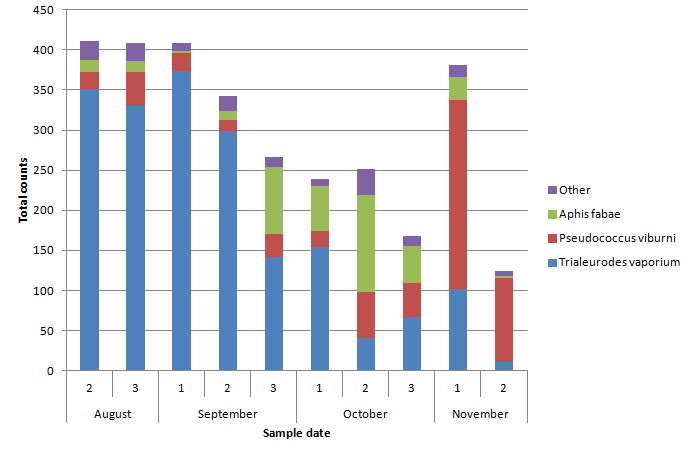Following two terms worth of data gathering for my final year project I have got an idea of the diversity of pests and their rate of spread int he tropical greenhouse. Below are two figures with the compiled total counts of each different pest type on leaves and fruits/ stems; from August to November 2012.
The purple bars or ‘other’ pests include Thrips, Scale insects, Spider mites, Fungus gnats and the aphid species; Aulacorthum solani. These pests were present in significantly lower numbers than ‘the top 3’ so have been grouped together. By the ‘top 3’ I refer to the Aphid Aphis fabae, Whitefly Trialeurodes vaporariorum and Mealybug Pseudococcus viburni. The total numbers of A. fabae and T. vaporariorum began to dwindle in the winter months, especially November. However mealybug populations continued to grow through these months, which is a characteristic of this particular species.
P. viburni or the glasshouse mealybug does not exhibit a winter diapause period and continues to reproduce all year long.
Cosmopolitan aphids like A. fabae on the other hand have two sets of hosts which they live on, a primary set (which they overwinter on and lay eggs) and a much wider secondary set which they occupy for the rest of the year. The plants in the glasshouse acted as secondary hosts for this species, on which they fed predominantly during the summer in hotter temperatures.
I counted whiteflies mostly on the leaves of plants which reflects the lifestyle of these pests. Adults are small moth like flying insects that lay eggs on the underside of leaves. Upon hatching the larvae crawl around a plant and find a suitable place to settle, usually on the underside of a leaf. A fully grown adult will then emerge from the developed puparium through a t shaped cut. This is interesting because it can be used as an indication of whether an empty larval casing gave rise to a healthy adult whitefly or a parasitoid wasp such as the species Encarsia formosa, which emerge from a circular hole.


